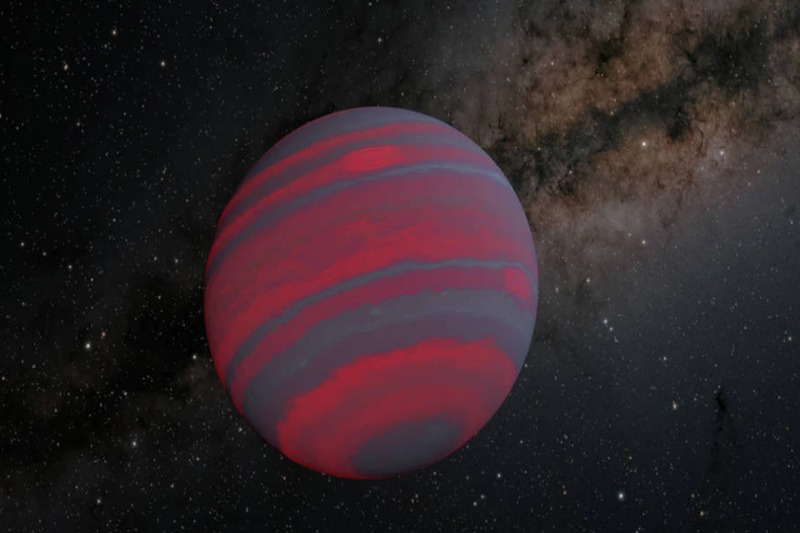Using NASA’s James Webb Space Telescope, astronomers have discovered a brown dwarf, an object smaller than a star but more massive than Jupiter, that is emitting methane infrared light, most likely as a result of energy from its upper atmosphere. This is a surprising finding because there is no obvious source for the energy in the upper atmosphere because W1935, the brown dwarf, is cold and does not have a host star. The group hypothesizes that aurorae-producing mechanisms could be the cause of the methane emission.
These results are being presented at the American Astronomical Society’s 243rd meeting in New Orleans.
The team looked to our solar system for clues to help them understand the mystery behind the methane’s infrared emission. Giants like Jupiter and Saturn are examples of gas giants that frequently emit methane. Aurorae are associated with the upper-atmosphere warmth that drives this emission.
When intense particles blasted into space from the Sun are caught by Earth’s magnetic field, aurorae are produced on Earth. Along magnetic field lines close to Earth’s poles, they tumble down into our atmosphere, hitting with gas molecules to produce eerie, whirling curtains of light. Similar auroral processes involving interaction with the solar wind are shared by Jupiter and Saturn; however, additional auroral contributions are received from adjacent active moons such as Enceladus (for Saturn) and Io (for Jupiter).
The lack of a stellar wind to fuel the auroral process and account for the excess energy in the upper atmosphere needed for the methane emission is puzzling for isolated brown dwarfs such as W1935. The group speculates that the emission might be explained by either unknown external interactions with interstellar plasma or a neighboring active moon, or by unknown internal processes such as the atmospheric phenomena of Jupiter and Saturn.
An Investigative Narrative
The discovery of the aurorae unfolded like a detective narrative. A group headed by astronomer Jackie Faherty of the American Museum of Natural History in New York was given access to the Webb telescope so they could study twelve cool brown dwarfs. These included W2220, an object found by NASA’s Wide Field Infrared Survey Explorer, and W1935, an object found by citizen scientist Dan Caselden, who worked with the Backyard Worlds Zooniverse project. Webb disclosed in great detail that W1935 and W2220 seemed to be near compositional clones of one another.In addition, they had comparable temperatures, brightness, and spectral characteristics to water, ammonia, carbon dioxide, and carbon monoxide. The notable exception was the observation of methane emission from W1935, which contrasted sharply with the expected absorption feature toward W2220. This was observed at a particular infrared wavelength that only Webb can detect.
“We expected to see methane because methane is all over these brown dwarfs. But instead of absorbing light, we saw just the opposite: The methane was glowing. My first thought was, what the heck? Why is methane emission coming out of this object?” said Faherty.
The scientists deduced potential causes for the emission using computer models. Based on the modeling study, W2220’s energy distribution across the atmosphere was found to be as expected, becoming colder as altitude increased. W1935, however, yielded an unexpected outcome. The most accurate model supported a temperature inversion, in which elevation caused the atmosphere to warm.
“This temperature inversion is really puzzling,” said Ben Burningham, a co-author from the University of Hertfordshire in England and lead modeler on the work. “We have seen this kind of phenomenon in planets with a nearby star that can heat the stratosphere, but seeing it in an object with no obvious external heat source is wild.”
Suggestions from the Solar System
The crew searched their own neighborhood and the planets in the solar system for hints. The gas giant planets can be used as stand-ins for observations made in the atmosphere of W1935, which is located almost 40 light-years away.
The group came to the conclusion that planets like Jupiter and Saturn frequently experience temperature inversions. Although research into the origins of their stratospheric heating is still underway, the two most popular explanations for the solar system’s heating are internal energy transmission from deeper in the atmosphere and external heating by aurorae.
Contextualizing Brown Dwarf Aurora Candidates
This is not the first time an observation of a brown dwarf has been explained by an aurora. Scientists have identified radio emission originating from multiple warmer brown dwarfs and have suggested that aurorae are most likely the cause. To further understand the phenomenon, ground-based observatories such as the Keck Observatory searched for infrared signatures from these radio-emitting brown dwarfs, but the results were equivocal.
The first auroral candidate having the signature of methane emission from outside the solar system is W1935. With an effective temperature of roughly 400 degrees Fahrenheit (200 degrees Celsius), it is also the coldest auroral contender outside of our solar system, 600 degrees Fahrenheit warmer than Jupiter.
The solar wind is the main source of auroral processes in the solar system, and planets like Jupiter and Saturn are influenced by active moons like Io and Enceladus. Since W1935 has no partner star at all, the event cannot be explained by a stellar wind. Whether an active moon contributes to the methane release on W1935 is still unknown.
“With W1935, we now have a spectacular extension of a solar system phenomenon without any stellar irradiation to help in the explanation,” Faherty noted. “With Webb, we can really ‘open the hood’ on the chemistry and unpack how similar or different the auroral process may be beyond our solar system,” she added.
The best space scientific observatory in the world is the James Webb Space Telescope. Webb is delving into the enigmatic structures and beginnings of our universe and our place within it, as well as uncovering riddles inside our solar system and exploring far-off worlds orbiting other stars. The European Space Agency (ESA) and the Canadian Space Agency are partners in the multinational Webb program, which is headed by NASA.
Topics #Aurorae Signs #Brown Dwarf #NASA










